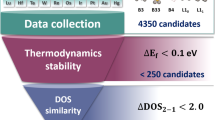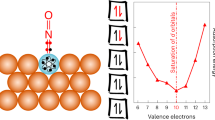Abstract
The pace of materials discovery for heterogeneous catalysts and electrocatalysts could, in principle, be accelerated by the development of efficient computational screening methods. This would require an integrated approach, where the catalytic activity and stability of new materials are evaluated and where predictions are benchmarked by careful synthesis and experimental tests. In this contribution, we present a density functional theory-based, high-throughput screening scheme that successfully uses these strategies to identify a new electrocatalyst for the hydrogen evolution reaction (HER). The activity of over 700 binary surface alloys is evaluated theoretically; the stability of each alloy in electrochemical environments is also estimated. BiPt is found to have a predicted activity comparable to, or even better than, pure Pt, the archetypical HER catalyst. This alloy is synthesized and tested experimentally and shows improved HER performance compared with pure Pt, in agreement with the computational screening results.
This is a preview of subscription content, access via your institution
Access options
Subscribe to this journal
Receive 12 print issues and online access
$259.00 per year
only $21.58 per issue
Buy this article
- Purchase on Springer Link
- Instant access to full article PDF
Prices may be subject to local taxes which are calculated during checkout





Similar content being viewed by others
References
Greeley, J. & Mavrikakis, M. Alloy catalysts designed from first principles. Nature Mater. 3, 810–815 (2004).
Muller, R. P., Philipp, D. M. & Goddard, W. A. Quantum mechanical-rapid prototyping applied to methane activation. Top. Catalys. 23, 81–98 (2003).
Andersson, M. P. et al. Towards computational screening in heterogeneous catalysis: Pareto-optimal methanation catalysts. J. Catalys. 239, 501–506 (2006).
Greeley, J., Nørskov, J. K. & Mavrikakis, M. Electronic structure and catalysis on metal surfaces. Annu. Rev. Phys. Chem. 53, 319–348 (2002).
Toulhoat, H. & Raybaud, P. Kinetic interpretation of catalytic activity patterns based on theoretical chemical descriptors. J. Catalys. 216, 63–72 (2003).
Linic, S., Jankowiak, J. & Barteau, M. A. Selectivity driven design of bimetallic ethylene epoxidation catalysts from first principles. J. Catalys. 224, 489–493 (2004).
Ceder, G. et al. Identification of cathode materials for lithium batteries guided by first-principles calculations. Nature 392, 694–696 (1998).
Besenbacher, F. et al. Design of a surface alloy catalyst for steam reforming. Science 279, 1913–1915 (1998).
Franceschetti, A. & Zunger, A. The inverse hand-structure problem of finding an atomic configuration with given electronic properties. Nature 402, 60–63 (1999).
Vitos, L., Korzhavyi, P. A. & Johansson, B. Stainless steel optimization from quantum mechanical calculations. Nature Mater. 2, 25–28 (2003).
Jacobson, M. Z., Colella, W. G. & Golden, D. M. Cleaning the air and improving health with hydrogen fuel-cell vehicles. Science 308, 1901–1905 (2005).
Hamann, C. H., Hamnett, A. & Vielstich, W. Electrochemistry (Wiley-VCH, Weinheim, 1998).
Lide, D. R. (ed.) CRC Handbook of Chemistry and Physics (CRC Press, New York, 1996).
Conway, B. E. & Bockris, J. O. M. Electrolytic hydrogen evolution kinetics and its relation to the electronic and adsorptive properties of the metal. J. Chem. Phys. 26, 532–541 (1957).
Parsons, R. The rate of electrolytic hydrogen evolution and the heat of adsorption of hydrogen. Trans. Faraday Soc. 54, 1053–1063 (1958).
Gerischer, H. Mechanism of electrolytic discharge of hydrogen and adsorption energy of atomic hydrogen. Bull. Soc. Chim. Belg. 67, 506 (1958).
Trasatti, S. Work function, electronegativity, and electrochemical behaviour of metals. III. Electrolytic hydrogen evolution in acid solutions. Electroanal. Chem. Interfacial Electrochem. 39, 163–184 (1972).
Krishtalik, L. I. On the influence of hydrogenation of the cathode metal upon the overvoltage of hydrogen. Electrokhimiya 2, 616 (1966).
Sabatier, P. Hydrogénations et deshydrogénations par catalyse. Ber. Deutschen Chem. Gesellschaft 44, 1984 (1911).
Nørskov, J. K. et al. Trends in the exchange current for hydrogen evolution. J. Electrochem. Soc. 152, J23–J26 (2005).
Greeley, J., Kibler, L., El-Aziz, A. M., Kolb, D. M. & Nørskov, J. K. Hydrogen evolution over bimetallic systems: Understanding the trends. ChemPhysChem 7, 1032–1035 (2006).
Nørskov, J. K. et al. Origin of the overpotential for oxygen reduction at a fuel-cell cathode. J. Phys. Chem. B 108, 17886–17892 (2004).
Casado-Rivera, E. et al. Electrocatalytic activity of ordered intermetallic phases for fuel cell applications. J. Am. Chem. Soc. 126, 4043–4049 (2004).
Markovic, N. M. & Ross, P. N. Surface science studies of model fuel cell electrocatalysts. Surf. Sci. Rep. 45, 121–229 (2002).
Schmidt, T. J., Stamenkovic, V. R., Lucas, C. A., Markovic, N. M. & Ross, P. N. Surface processes and electrocatalysts on the Pt(hkl)/Bi-solution interface. Phys. Chem. Chem. Phys. 3, 3879–3890 (2001).
Gómez, R., Fernández-Vega, A., Feliu, J. M. & Aldaz, A. Hydrogen evolution on Pt single-crystal surfaces—effects of irreversibly adsorbed bismuth and antimony on hydrogen adsorption and evolution on Pt(100). J. Phys. Chem. 97, 4769–4776 (1993).
Gómez, R., Feliu, J. M. & Aldaz, A. Effects of irreversibly adsorbed bismuth on hydrogen adsorption and evolution on Pt(111). Electrochim. Acta 42, 1675–1683 (1997).
Bowles, B. J. Formation and desorption of monolayers of bismuth on a platinum electrode. Electrochim. Acta 15, 737 (1970).
Clavilier, J., Feliu, J. M. & Aldaz, A. An irreversible structure sensitive adsorption step in bismuth underpotential deposition at platinum-electrodes. J. Electroanal. Chem. 243, 419–433 (1988).
Hayden, B. E., Murray, A. J., Parsons, R. & Pegg, D. J. UHV and electrochemical transfer studies on Pt(110)-(1x2): The influence of bismuth on hydrogen and oxygen adsorption, and the electro-oxidation of carbon monoxide. J. Electroanal. Chem. 409, 51–63 (1996).
Evans, R. W. & Attard, G. A. The redox behavior of compressed bismuth overlayers irreversibly adsorbed on Pt(111). J. Electroanal. Chem. 345, 337–350 (1993).
Hamm, U. W., Kramer, D., Zhai, R. S. & Kolb, D. M. On the valence state of bismuth adsorbed on a Pt(111) electrode: an electrochemistry, LEED, and XPS study. Electrochim. Acta 43, 2969–2978 (1998).
Kizhakevariam, N. & Stuve, E. M. Coadsorption of bismuth with electrocatalytic molecules—a study of formic-acid oxidation on Pt(100). J. Vac. Sci. Technol. A 8, 2557–2562 (1990).
Vetter, K. J. Electrochemical Kinetics: Theoretical and Experimental Aspects (Academic, New York, 1967).
Paffett, M. T., Campbell, C. T. & Taylor, T. N. The influence of adsorbed Bi on the chemisorption properties of Pt(111)— H2, CO, and O2 . J. Vac. Sci. Technol. A 3, 812–816 (1985).
Paffett, M. T., Campbell, C. T. & Taylor, T. N. Adsorption and growth modes of Bi on Pt(111). J. Chem. Phys. 85, 6176–6185 (1986).
Hammer, B., Hansen, L. B. & Nørskov, J. K. Improved adsorption energetics within density-functional theory using revised Perdew-Burke-Ernzerhof functionals. Phys. Rev. B 59, 7413–7421 (1999).
Bengtsson, L. Dipole correction for surface supercell calculations. Phys. Rev. B 59, 12301–12304 (1999).
Vanderbilt, D. Soft self-consistent pseudopotentials in a generalized eigenvalue formalism. Phys. Rev. B 41, 7892–7895 (1990).
Kresse, G. & Furthmuller, J. Efficiency of ab-initio total energy calculations for metals and semiconductors using a plane-wave basis set. Comput. Mater. Sci. 6, 15–50 (1996).
Humphrey, W., Dalke, A. & Schulten, K. VMD—visual molecular dynamics. J. Mol. Graph. 14, 33–38 (1996).
Acknowledgements
J.G. and T.F.J. acknowledge H. C. Ørsted Postdoctoral Fellowships from the Technical University of Denmark. J.B. acknowledges support from the Danish Strategic Research Council. The Center for Individual Nanoparticle Functionality is supported by the Danish National Research Foundation. The Center for Atomic-scale Materials Design is supported by the Lundbeck Foundation. We thank the Danish Center for Scientific Computing for computer time. We also thank K. P. Jørgensen and J. Larsen for technical assistance.
Author information
Authors and Affiliations
Corresponding author
Ethics declarations
Competing interests
The authors declare no competing financial interests.
Supplementary information
Supplementary Information
Supplementary figures S1 and S2 (PDF 164 kb)
Rights and permissions
About this article
Cite this article
Greeley, J., Jaramillo, T., Bonde, J. et al. Computational high-throughput screening of electrocatalytic materials for hydrogen evolution. Nature Mater 5, 909–913 (2006). https://doi.org/10.1038/nmat1752
Received:
Accepted:
Published:
Issue Date:
DOI: https://doi.org/10.1038/nmat1752
This article is cited by
-
Unusual Sabatier principle on high entropy alloy catalysts for hydrogen evolution reactions
Nature Communications (2024)
-
Non-bonding modulations between single atomic cerium and monodispersed selenium sites towards efficient oxygen reduction
Nano Research (2024)
-
Precisely Control Relationship between Sulfur Vacancy and H Absorption for Boosting Hydrogen Evolution Reaction
Nano-Micro Letters (2024)
-
Design and Photocatalytic Performance of the New Direct Z-Scheme Heterojunction XSe2/Sih (X = Zr, Sn) for Overall Water Splitting
Catalysis Letters (2024)
-
Enhanced hydrogen evolution reaction in FePt film with remanence due to decrease in domain walls
Rare Metals (2024)



